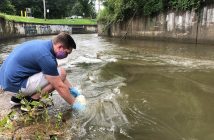A new tool empowers anyone with a web browser to observe water’s constantly shifting courses, an International Water Association report reveals

A team at Deltares, a water research institute based in Delft in the Netherlands, has unveiled a revolutionary tool that allows anyone, anywhere, to visually monitor the comings and goings of the Earth’s surface water on a timeline from 1985 through to the present.
Access to the technology is free, providing everyone with a fascinating open access window on our thirsty world.
“The Aqua Monitor is a set of mathematical equations,” explains Jaap Kwadijk, Deltares Scientific Director.
“It provides you with information on how much water has turned into land, and how much land has turned into water.
“It allows us to look to trends in climate change.
“Scientists can look to see where the world is becoming wetter or drier.
“This has never been done before.”
The tool is anchored by Google Earth Engine, which incrementally stores satellite images over time, and script data to access it.
It also relies on four Landsat earth-observing satellite missions, managed by the United States Geological Survey (USGS) and the North American Space Agency (NASA).
The technology provides a pixilated composition at a resolution of 30 metres, making it simple and accessible to any curious surfer with a Wi-Fi connection.
Zooming in, green indicates where land has overtaken water; blue reveals the spread of water.
Big gains
Nature Climate Change published their paper on the global results: the world has gained 115,000 km2 of water and 173,000 km2 of land over the past 30 years.
Two areas were identified to provide the largest contribution regarding surface water gains (Tibetan Plateau) and losses (Aral Sea).
“Globally, a surface equal to the area of Washington State was converted from water to land,” Hessel Winsemius, a Deltares hydrological expert explained in a webinar, “while an area two-thirds of that was converted from land to water.”
Contrary to expectations of widespread coastal erosion, Deltares researchers discovered a surprising amount of residential land reclamation strategies, most aggressively off Dubai, Singapore, the Netherlands, and especially southern China.
The latter shows, “almost unimaginable” coastline land growth from Hong Kong to the Yellow Sea within the last decade.
He points out some of the many dam reservoirs shown to be filling in behind the borders of politically closed, opaque countries. “We see quite a few of them popping up every year, more than reported.”
Indeed, Myanmar had listed the creation of 400 square kilometres of new reservoir surface area, when Aqua Monitor counts 1,180 square kilometres, nearly three times that amount.
It also showed the previously unmapped damming of the disputed transboundary Rimjin River east of South Korea’s border, by North Korea’s Hwanggang Dam.
The heightened scrutiny, and awareness of transparency, may have political repercussions on decision-making and national security relations among basin-sharing states of transboundary rivers.
Any local, regional or global water professional–or for that matter layman who requires objective water information–can use the tool to look upstream and downstream at new man-made water or land, wetland loss, sedimentation, or coastal erosion.




